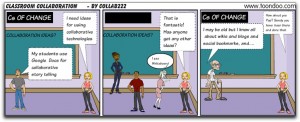Posts tagged courseware
E-Learning Courseware Tools
1An online classroom offers more provisions to use web-based tools than a face-to-face classroom might. For Weber Online, we are using the Utah Electronic High School’s (EHS) curriculum, but our plan is to “update” it to model better practices, and Web 2.0, which have gotten increasingly sophisticated, will undoubtedly play an important role in this. Modern students, both young and old, thrive with richly interactive web tools, especially as the next generations will be increasingly comfortable and familiar with interactive web-based environments.
Udutu
Udutu is a courseware development tool that allows the teacher to make non-linear Flash-based lessons with multimedia, quizzes, and activities. The lessons are far more visually appealing than simply reading a giant page of textual information, which is how EHS courses are currently set up. Thought-provoking activities such as roleplays are ideal for Udutu lessons. What’s more, you can import Flash (SWF) files into the course you develop, which opens up numerous possibilities to integrate Udutu with other Web 2.0 tools, and existing materials on the web.
For example, typing “photosynthesis filetype:swf” will yield a number of Flash animations that could be imported for a lesson on plants, such as http://dendro.cnre.vt.edu/forestbiology/photosynthesis.swf Searching for “nuclear fission filetype:swf” yields a number of good animations on nuclear fission, such as http://www.british-energy.com/swf/fission.swf. Before importing anything, it is a good idea to make sure you’re not running afoul of copyright and fair use restrictions, and make sure you include a link to the source.
Animoto
If you have a segment of your lesson that’s heavy on photos or short videos, you can use Animoto to create an eye-catching musical video with interspersed text, and add this to a Udutu page. It only takes a few minutes to design a video with Animoto, though you may have to wait awhile for it to fully render it. Make sure you sign up with Animoto for Education to take advantage of the special longer videos they offer to teachers, for free.
ToonDoo
 ToonDoo is a comic strip creator. Students may respond to instructional material better when a virtual character is guiding and co-learning the material with them (Spierling, 2005). ToonDoo allows you to place virtual characters in scenes, arrange relevant props around them, then use captions to share instructional content. Due to the limited-text nature of comics, these shouldn’t be used as the primary tool in delivering instructional material, but to emphasize key points of lessons conveyed through other more conventional means, such as text, audio, etc.
ToonDoo is a comic strip creator. Students may respond to instructional material better when a virtual character is guiding and co-learning the material with them (Spierling, 2005). ToonDoo allows you to place virtual characters in scenes, arrange relevant props around them, then use captions to share instructional content. Due to the limited-text nature of comics, these shouldn’t be used as the primary tool in delivering instructional material, but to emphasize key points of lessons conveyed through other more conventional means, such as text, audio, etc.
References
Spierling, U. (2005). Beyond virtual tutors: Semi-autonomous characters as learning companions. ACM SIGGRAPH 2005 Educators program, SIGGRAPH ’05. Los Angeles, California: ACM.
